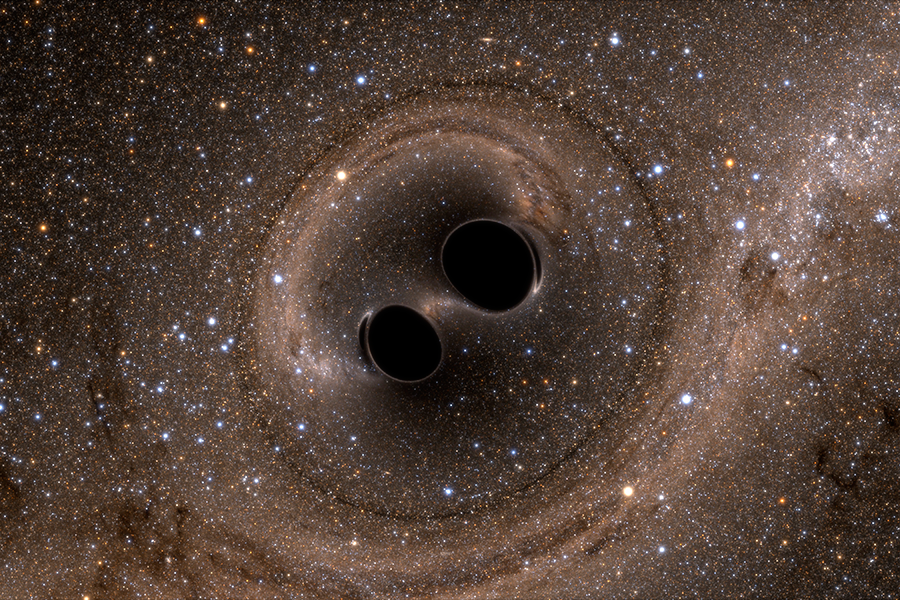Space-time ripples: How Einstein's gravitational waves are detected
Loading...
In what some scientists are calling a discovery as monumental for astronomy as Galileo first using a telescope to study the planets in the early 17th century, a team of international researchers says it has proven that black holes exist in the universe by detecting the gravitational waves formed after one pair collided in space 1.3 billions years ago.
This was the first time scientists were able to physically detect gravitational waves, or ripples through spacetime caused by far-off, violent cosmic collisions, by using incredibly sophisticated, giant detectors located in Hanford, Wash., and Livingston, La.
The waves were detected on September 14, having rippled through spacetime for 1.3 billion years before reaching Earth in a cosmic message sent here from a time when multicellular life was just beginning to spread on this planet.
They originated during the split second when two black holes, which form when a massive star collapses in upon itself, collided and merged into one, after orbiting each other in a gravitational dance for billions of years.
The power of the brief collision was massive: 50 times greater than all of the power of all the stars in the universe put together. This caused gravitational ripples, like the water ripples formed when a pebble is dropped into a pond, to “propagate towards Earth carrying the news of the collision,” as Kip Thorne, a theoretical physicist at the California Institute of Technology, said today at a highly anticipated press briefing in Washington, DC, where giddy scientists relayed their findings to a room packed with people and 90,000 others watching online.
Scientists said they can even estimate, based on the signal the detectors picked up, that one black hole was 29 times the mass of the sun, and the other 36 times.
“It’s the first time the universe has spoken to us through gravitational waves,” said David Reitze, executive director of the Advanced Laser Interferometer Gravitational-Wave Observatory (LIGO) experiment, a collaboration of more than 1,000 scientists around the globe who have been working to identify these waves with remarkably sensitive laser interferometers.
The interferometers are two-and-a-half-mile (4-km) long L-shaped tubes through which laser light is split into two beams that travel back and forth down the tube arms. The beams are used to monitor the distance between mirrors placed at the ends of the arms. The distance between the mirrors should change by an infinitesimal amount when a gravitational wave passes by the detector, as Albert Einstein, the father of gravitational waves, had predicted.
The machines can detect changes in the distance between the mirrors that’s smaller than one-ten-thousandth the diameter of a proton, says LIGO.
Scientists say they know that the signal wasn’t a fluke or some other earthly disturbance because both detectors, more than 2,000 miles apart, felt the same wave within milliseconds of each other.
“We analyzed data from two detectors because when measuring tiny distortions here on Earth, you can only believe they’re real if you see them at the same time in two different places” explained Gabriela González, a a LIGO spokesperson and professor of physics and astronomy at Louisiana State University.
Astronomers have expected that gravitational waves exist, but LIGO is the first to prove it. Now that they’re detectable, these waves could lead scientists back in time to the formation of the universe some 14 billion years ago, where cataclysmic explosions from merging black holes, supernovae, and even the Big Bang itself, formed ripples that potentially are still making their way back to Earth.
“This is not just about the detection of gravitational waves,” pointed out Dr. Reitze. “That’s the story today, but what’s really exciting is what comes next.”
These findings will help astronomers in their quest to figure out how many black holes are out there, how galaxies formed, how many neutron stars there are, and to evaluate cosmic string theory.
“Einstein would be beaming, wouldn’t he?” said France Córdova, director of the National Science Foundation, which has been funding LIGO since 1992.
Albert Einstein first predicted gravitational waves in 1915, in his general theory of relativity. He also predicted black holes, though only as a mathematical construct. It took decades of science for astronomers to show that black holes are actual physical objects.
LIGO scientists know that the waves they detected on Earth are coming from the collision of black holes because supercomputer simulations based on Einstein’s first mathematical theories about black holes, and later mathematical descriptions of how they behave when they collide, mapped the same wave pattern.
“This is mind blowing,” said Manuela Campanelli, director of the Center for Computational Relativity and Gravitation at the Rochester Institute of Technology. Her group published one of three papers in 2005 – the others were from Princeton University and NASA Goddard Space Center – that solved Einstein’s equations for colliding black holes for the first time. LIGO’s physical observations of gravitational waves on September 14 perfectly matched mathematical models of colliding black holes.








